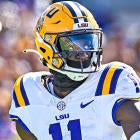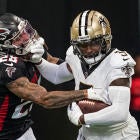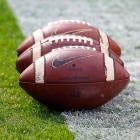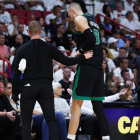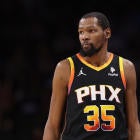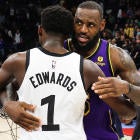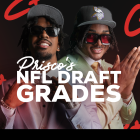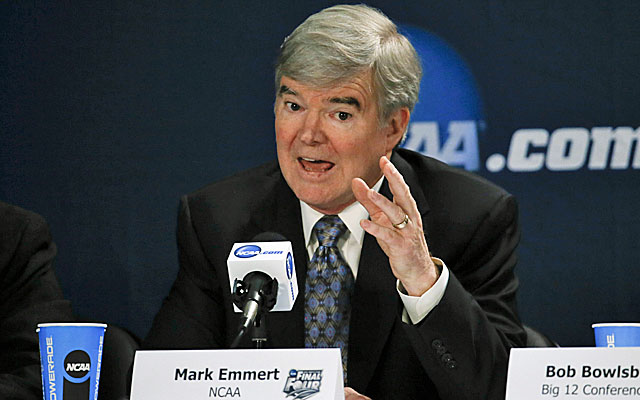
More: O'Bannon news | On CFB: Dennis Dodd | Jeremy Fowler | Jon Solomon
The collegiate model is dead. The only amateur system of its kind in the world is kaput.
It doesn't matter if there are stipulations or that Friday's shocking O’Bannon ruling is somehow interpreted as "NCAA friendly." That’s not the point. The point is that the NCAA said the sky would fall if this day ever came.
In Indianapolis, the forecast was cloudy with a chance of total collapse at 700 W. Washington St. But the only thing falling was the archaic concepts held dear at that home address of the NCAA.
A federal judge in Northern California ruled in the rancorous five-year O'Bannon suit to allow football and basketball players to have as much as $20,000 waiting for them at the end of their eligibility.
Those players -- the judge further ruled -- deserved to be compensated for their names, image and likeness in the media. For decades the NCAA not only capitalized on those NILs but forbade players from seeing any of the money themselves while in school.
Now, the schools – the NCAA's membership lifeblood – are going to have to pay -- more. The judge capped that per-year trust fund money at $5,000. Combine that with Thursday’s ruling on autonomy, and various players will be able to be compensated up to $40,000 by the time they leave school. (Cost of attendance, approximate $5,000 max x 4 + NIL trust, $5,000 max x 4 = $40,000.)
The NCAA will no doubt spin this as some sort of "win" after fully reading the decision (and a couple of stiff drinks). There will be an appeal. Of course, there be will an appeal. The Supreme Court may one day rule against it. But a seal has been broken.
Players can be paid, and we can't turn back from here.
"I'm literally crying," said the man who helped organize the plaintiffs, "I'm in heaven."
That would be Sonny Vaccaro, the one-time, big-time shoe marketer who had the germ of an idea that blossomed into Friday's decision. Good for those who believed that the strict, byzantine collegiate model was outdated and not worth defending.
Bad for the NCAA which defended it all these decades.
Either way, Friday may have been the most historic day in NCAA history.
"This puts things in chaos," said a person with intimate knowledge of NCAA dealings in this case, "for a period of years."
Start with Title IX. The ruling is limited to football and basketball players. Some civil rights lawyer or another will be wanting an equal piece for women. That is a given. And that is fair.
From the looks of things, only the elite of the elite financial institutions will be able to afford such an expense. Schools are already on the hook for cost of attendance to be implemented beginning with the 2015-16 school year. That was the big news Thursday in the formal approval of autonomy.
Oh yes, players will be paid. Whether it's during school with a stipend or after school with cold, hard licensing cash doesn't matter. The NCAA has fought against facing this day for years. This decision goes against everything the association stands for.
Asked specifically by plaintiffs attorneys in June about the concept of "deferred compensation" for athletes, Mark Emmert said, "It's the same whether you're paid today or paid tomorrow. ... To convert college sports into professional sports would be tantamount to converting it to minor-league sports."
By Emmert’s definition, NCAA sports just turned pro.
In an ultimate irony, an organization that fights so hard against recruits being paid under the table on the front end will have to pay them legally on the back end. And if the whole thing goes through as presented Friday, look for another round of mind-bending, tradition-crushing conference realignment.
The elite of the elite will cluster together.
The underpinnings of the NCAA were based -- in part -- on a 1950s ruling against a player whose widow claimed he died from head injuries playing college football. Back then the term "student-athlete" was a contrived, NCAA-sponsored term adopted to combat Ray Dennison's workman's compensation claim.
The NCAA disagreed and eventually prevailed.
Welcome, then, to the official age of the athlete-student.
That leaves me wondering: What is the worth of the NCAA going forward?
It puts on a heck of basketball tournament, distributes the money. It sets the play and practice rules, but that's about it. It runs an enforcement division that is going to be under scrutiny in autonomy. Its legal standing, though, just slipped into the muck.
Fifteen years ago, the NCAA fought to the death an antitrust challenge after it capped the salaries of assistant coaches. It lost, resulting in what was then the largest legal setback in the association's history.
Then, as now, the NCAA could have settled saving everyone from costly upheaval.
Next up on the docket: A rash of lawsuits calling for an open market that would pay players (further) dot the landscape.
All of the battles went to defending that collegiate model, the only one like it on earth. It allows commissioners and coaches to rake in millions, while the unpaid labor force puts its bodies on the line.
Somewhere along the line, the NCAA lost the discussion. Not just the argument, the entire discussion. If you don't get the "labor force" reference – the NCAA hates it by the way -- then why is autonomy referred to as "student-athlete welfare"? That alone implies there was a lack of welfare.
The NCAA is caught somewhere between being benevolent Big Brother and losing its grip on that membership.
Some maintain the NCAA will eventually morph into a sort of Olympic model where athletes are able to earn money while in school. Does that professionalize them? It certainly didn't professionalize those cuddly figure skaters and heroic Olympic sprinters who worm their way into our hearts every couple of years.
All of this was inevitable. The NCAA has been woefully slow to change. Six years ago, a confidential white paper was distributed to the association's board of directors, according to a source. It was meant to be an exploratory discussion into obtaining an antitrust exemption from the federal government.
While the odds were probably as long as they are now, Congress is interested. Some may suggest intrusive.
A tipping point came about three years ago when a common-sense stipend ($2,000 per year) was passed under the NCAA's old legislative system. Enough of the 351 Division I rebelled causing an override vote. They couldn't afford $2,000 a year, so that common-sense measure died a cold, heartless death.
That's when those Power 5 commissioners had enough. It was time to recognize who really ran things in the NCAA. And if you couldn't keep up, too bad for you.
"We are the ones making the money and carrying the liability," Texas AD Steve Patterson said. "The others don't make any money. Nobody wants to watch them on TV. I don't accept the argument that you have to have total socialism."
So much for collegiality. Patterson may be the new, bottom-line, arrogant, face of college athletics. This is the same guy who said this week at a Big 12 college athletics forum the sky is falling -- sound familiar? -- if athletes are paid. This from a career NBA/NFL/minor-league hockey bureaucrat who currently runs the richest athletic department in the country ($175 million in revenue).
What, you can't share some of that, Steve-o? It's a bit hypocritical. Your football/basketball players are being asked to play for nothing while producing revenue to be shared by the university.
But on Friday, the whole thing flipped. The collegiate model died.












